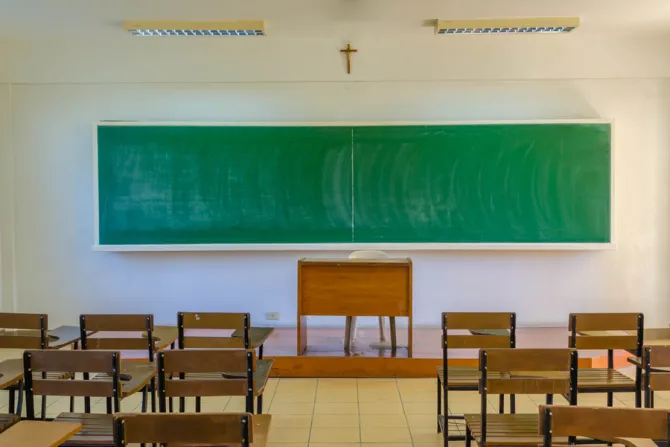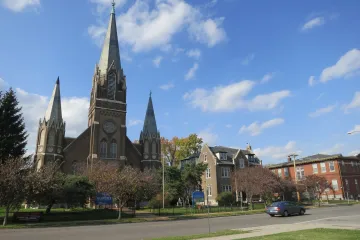St. Louis, Mo., Sep 28, 2023 / 16:45 pm
The Archdiocese of St. Louis may close more than 25 Catholic elementary schools amid a major restructuring plan that has already closed and merged many parishes.
Roughly one-third of the 80 Catholic parish elementary schools in the Archdiocese of St. Louis will meet with representatives from the Office of Catholic Education and Formation and their Episcopal Vicar to consult on their current and future status, the archdiocese announced Sept. 27.
The schools being met with were chosen based on enrollment numbers, demographic trends, parish and school financial strength, and proximity to neighboring Catholic parish elementary schools, the announcement continued.
“While some Catholic parish elementary schools may be recommended by the parishes to close, others will enter a feasibility analysis phase,” the archdiocese, led by Archbishop Mitchell Rozanski, said.
Throughout October, the archdiocesan Office of Catholic Education and Formation and archdiocesan Episcopal Vicars will meet with pastors to discuss “the long-term sustainability of their parish elementary schools.”
“These meetings will be consultative in nature, and pastors will share and consider this information with parish and school leadership. Once this process is complete, pastors will return recommendations concerning their parish elementary schools to Archbishop Rozanski, much as they would under normal archdiocesan procedure,” the announcement continued.
“Pastors who believe their schools are sustainable long-term will be asked to consider their current processes, develop a feasibility plan, and engage in strategic planning efforts to create strong, viable Catholic elementary schools.”
The archdiocese said it expects to announce school changes in early December — possibly later for some schools — to be implemented for the 2024-2025 school year. The archdiocese previously said that in response to requests to raise teachers’ salaries, they are “looking at a new compensation model for our teachers to take effect for the 2023-24 academic year.”
St. Louis is not one of the country’s largest dioceses but has historically had a disproportionate number of students in its Catholic schools. As recently as last year, 38% of St. Louis’ Catholic elementary school-age children were in a Catholic school compared with 13% nationally, and 31% of Catholic high school-age children are in a Catholic school compared with 10% nationally.
Three Catholic schools in the archdiocese closed earlier this year — St. Rose Philippine Duchesne in Florissant, St. Mark in south St. Louis County, and Good Shepherd in Hillsboro. Also closed was Barat Academy, an independent Catholic high school in Chesterfield, the St. Louis Post-Dispatch reported. Closures for two other high schools — Rosati-Kain for girls and St. Mary’s for boys — were announced, but supporters raised enough money to keep the schools open independently.
Existing Catholic school building structures in the archdiocese are at roughly 65% capacity and, due to the archdiocese’s expansive footprint, many schools are “facing increased costs that are affecting tuition, declining enrollment often based on geography, increased building maintenance needs, and parishes that are unable to subsidize the cost of a school,” the archdiocese said.
The consultative process is part of a larger process of consolidation, branded “All Things New,” which is administered by the Pennsylvania-based Catholic Leadership Institute (CLI). It is very similar to the ones undertaken by CLI in recent years in other major midwestern archdioceses, such as Pittsburgh and Cincinnati.
Numerous factors, including increasing suburbanization and rising crime, have led in recent years to an exodus of people from St. Louis’ historic inner core, where the greatest number of large, historic parishes were clustered. Catholics have been gradually moving west for several decades, away from the city center along the Missouri River and toward the suburbs, leaving parishes in the more urban areas with smaller Catholic populations from which to draw.
Overall, in 2021, the number of Catholics in the Archdiocese of St. Louis dipped below 500,000 for the first time since the 1960s. The number of parishes would have likely exceeded the number of priests by 2026 without action, according to archdiocesan projections.
Rozanski’s final plans for the mergers and closures, announced in May, saw roughly 25% of the archdiocese’s parishes close or merge.
Some Catholics in the archdiocese were critical throughout the All Things New process, in part because of the shakeup of parishes. More than 3,000 Catholics in the archdiocese signed a petition that asked the archbishop to halt the plan last spring, but Rozanski ultimately declined to revoke any of the decrees he made regarding the final plans, leaving the parishes with recourse only to the Vatican.
(Story continues below)
As a result, at least eight parishes this summer announced plans to send appeals to the Vatican, putting aspects of the mergers planned for the parishes on hold until the Dicastery for the Clergy issues a ruling, which could take several months.
Before making the changes, the archdiocese held 350 listening sessions, with at least one in each of the parishes as they were at the time. It considered feedback from 70,000 Catholics in the archdiocese who participated in a survey. Feedback was also solicited from 18,000 school parents, staff, teachers, donors, and community partners. In addition, the archdiocese held focus groups and talked with civil and business leaders.
Rozanski said the feedback helped structure the final plan, which was approved by the All Things New Planning Committee. The committee included priests, deacons, parish life coordinators, lay leaders, and religious within the archdiocese. In addition to considering the feedback, they also looked into financial data and other information.






